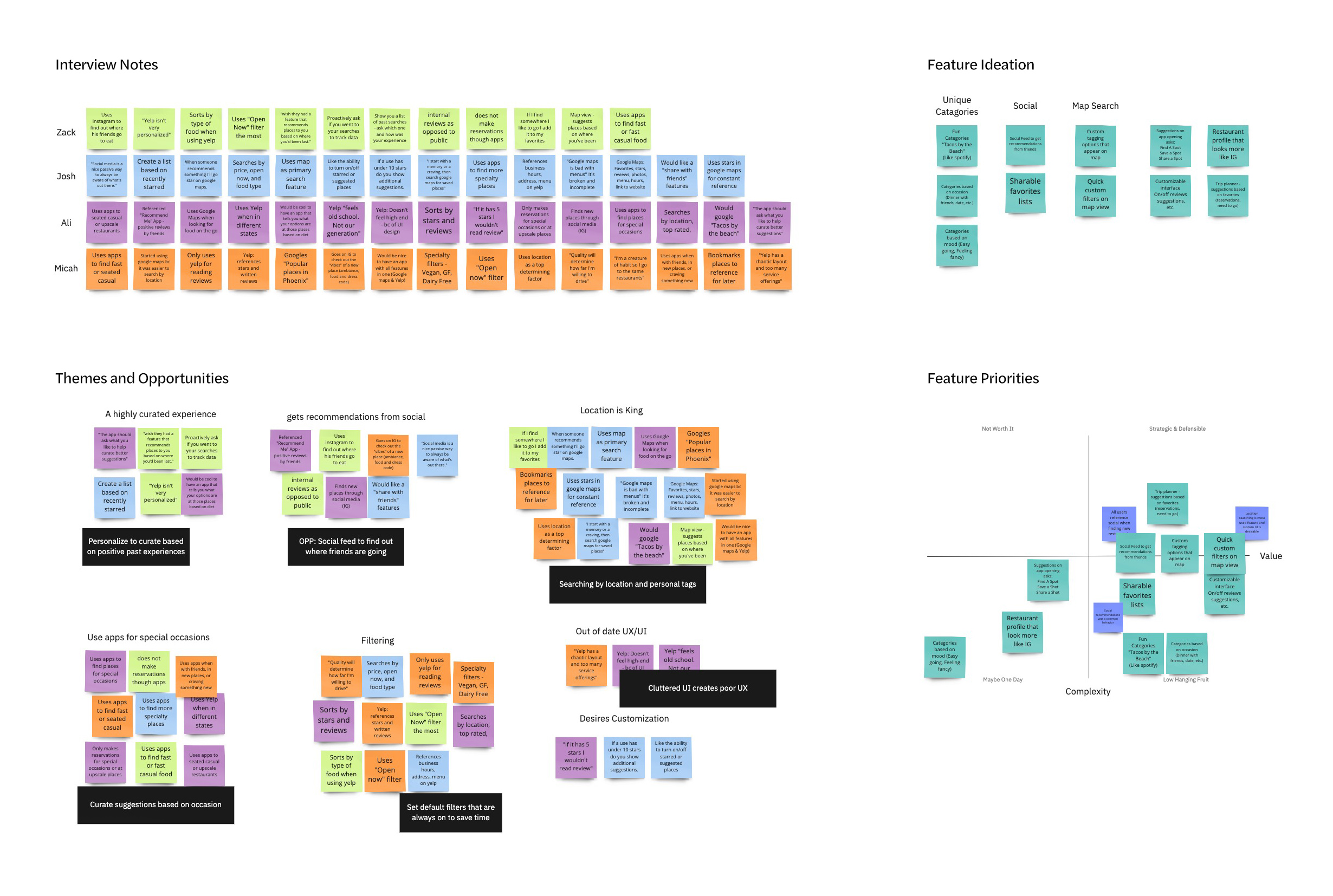2020
None
UX, UI, Product Design
UX/UI Designer

Dyne was created for true foodies, those who love to try new restaurants and keep a close eye on the local food scene. The die hards who organize and categorize their favorite places and love to share recommendations and experiences with friends. Dyne curates, personalizes, and streamlines the restaurant finding experience while connecting users to a network of fellow foodies.
Millennial foodies are frustrated with the current products they use to find restaurants that fit their preferences. While there are multiple apps to solve this problem, none successfully provide users with all the features they want to make a confident decision in one seamless experience. Instead, they flip between multiple apps to search and cross check what they find on the others, which makes for a very clunky and time consuming task.
Dyne integrates and improves upon the most used features of competing products to solve user pain points. Simplifying the process of finding reputable and desirable restaurant options, saving those new finds for future reference, and sharing them with friends.

UX research, UI design, brand identity

Initial research focused on better understanding user’s needs related to finding and saving restaurants as well as measuring the extent to which these needs are held among their peers.
What products exist to find, save and share restaurants?
How do users interact with existing products?
What are users current pain points with existing products?
Which features are essential to find restaurants?
A survey was conducted on 20 participants to identify which products and features people are currently using and determine which feature are essential to find a new restaurant.






A series of in-depth interviews were then conducted on 5 participants to further identify pain points, frustrations, needs, and desires with existing products to determine how Dyne could improve this experience.



All participants used a combination of multiple apps to find, save and share restaurants
Users value the ability to customize their settings to curate things that fit their preferences
Major products in the market lack desirable features and feel impersonal, outdated and untrustworthy
A map feature with tags is paramount when searching for restaurants
Too much information on screen makes users feel overwhelmed, they'd like a more curated experience
Irrelevant suggestions feel impersonal and clutter the UI, filters are highly used tools when searching
Competitive analysis was conducted to identify competitor's strengths and weaknesses to inform Dyne's features and information structure.

After conducting user interviews, all the participants responses were synthesized to identity themes, opportunities, and features that Dyne could focus and improve upon.
An affinity map was created to identify high level themes and group similar insights gained from the user interviews.

Using the four hues of the SimpleStage identity as a starting point, I expanded the color palette to accommodate the needs of the platform’s complex dashboard system.

A persona was built based on the data collected to help drive decision making and keep the product focused on solving users pain points, frustrations, and goals.

To kick-off the design process, quick sketches helped me get ideas on paper to establish which elements were necessary for each screen. A low fidelity prototype was then created for initial user testing.
The primary user flow is the process of searching, saving and sharing with friends.

Dyne's simple information structure makes it easy to navigate and move through tasks.

Rough sketches were done to get my initial thoughts on paper and brainstorm new ideas for specific UI elements.






Using the feedback and insights gained from research, analysis and sketching, a how-fidelity prototype was created to begin user testing.

A usability study was conducted to determine where improvements could be made and identify new ideas to satisfy user expectations, needs, and desires.

Source of restaurant review was unclear
Quick save option not available, had to specify which list to save to
Emphasis on photos made it difficult to find type of food and restaurant ratings
Use color to differentiate Dyne's suggestions from a users saved restaurants
Remove multi-step process to find social icons and make immediately visible
Add a moment of delight to let the user know a restaurant was saved
Inspiration was drawn from fine dining restaurants with a focus on minimal yet functional simplicity. The UI design reflects the user's desire to have a clutter free, curated look and feel.



Dyne makes the process of finding a restaurant, saving it for later, in house ordering, paying and reviewing/sharing it with friends simple and engaging. It connects people to a social network of fellow foodies and only suggests restaurants that match up with each user's preferences and positively reviewed and rated dining experiences.
Intro screen and onboarding

Users land on the map screen after signing in and when opening the app, making searches quick and easy.

After finding a restaurant, users can then save it and add it to as many lists as they'd like

After saving they can share it with their friends or friend groups

Users can follow friends and read their reviews or write a review and share pictures of their own dining experiences

Profiles feature a recommendation section where users can add their top rated spots

Dyne recommends restaurants based on a users location, friends, saved restaurants, and their positive posts and reviews.

Integrates all needs into one streamlined experience
Suggests more personalized restaurant recommendations
Supports social connection and engagement
Saves favorites for quick reference later
Gives users more flexibility to create specialized lists
Provides a source of reputable reviews from trusted friends and influencers